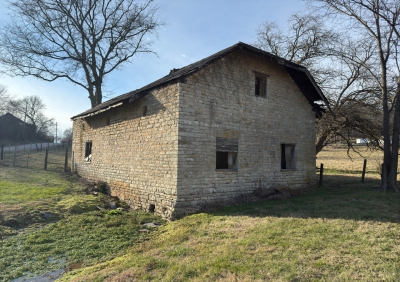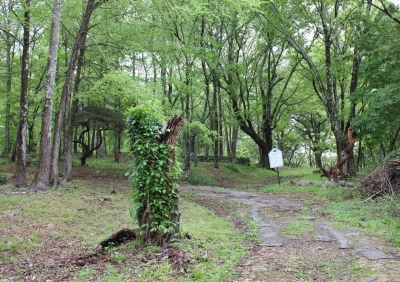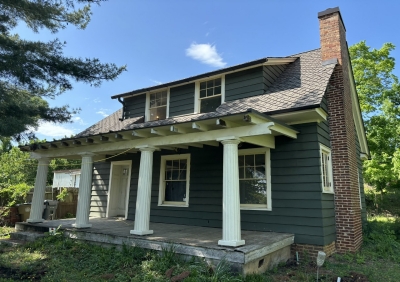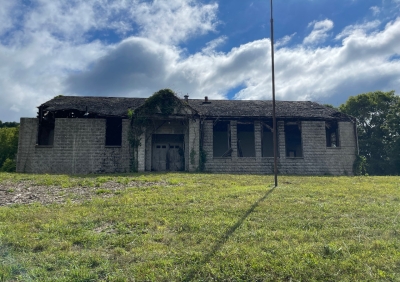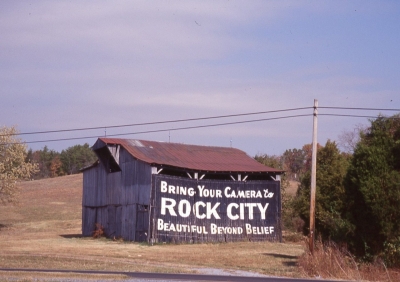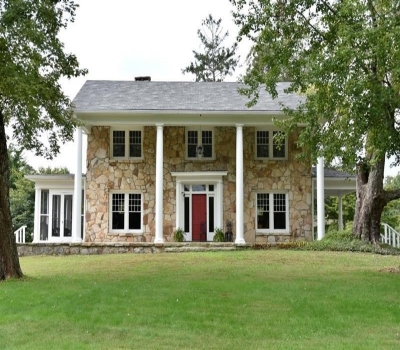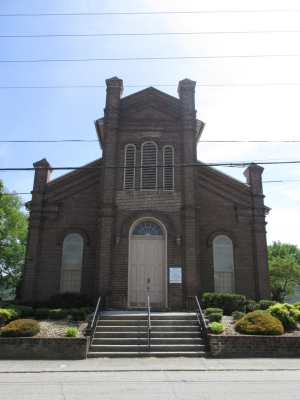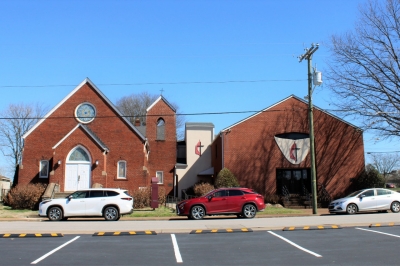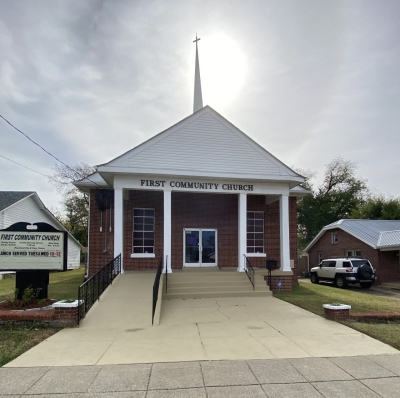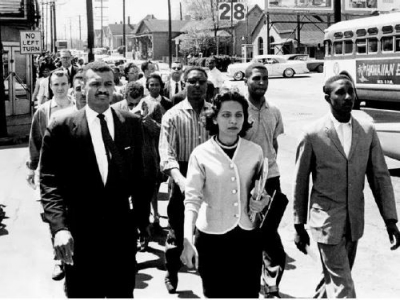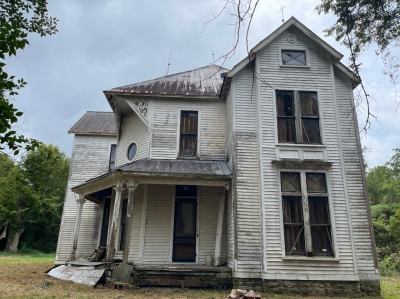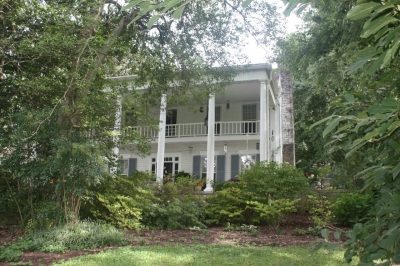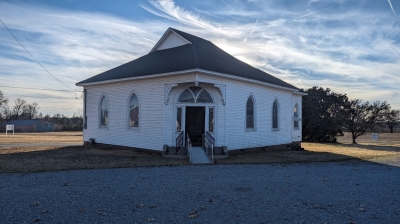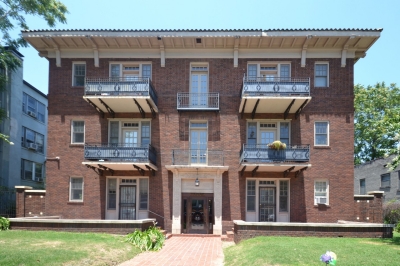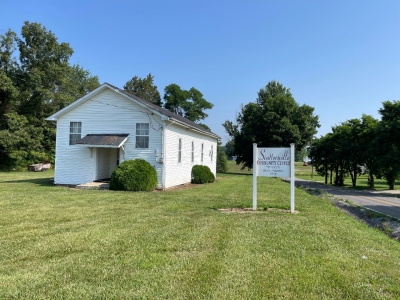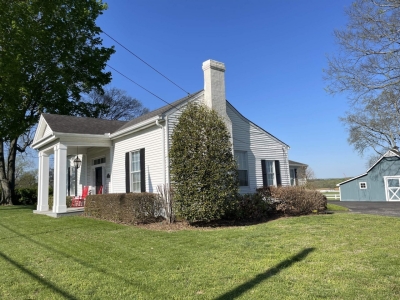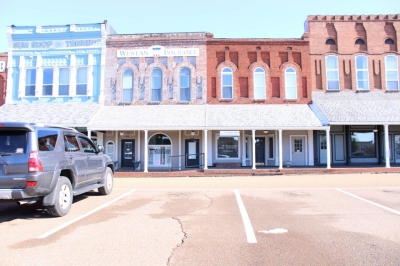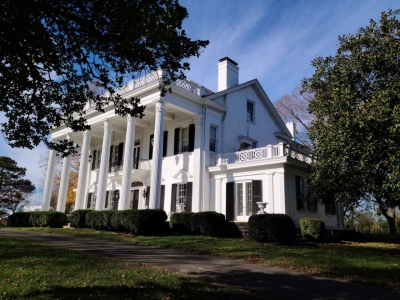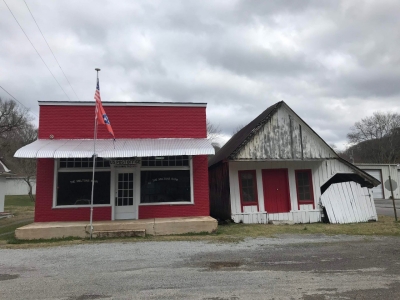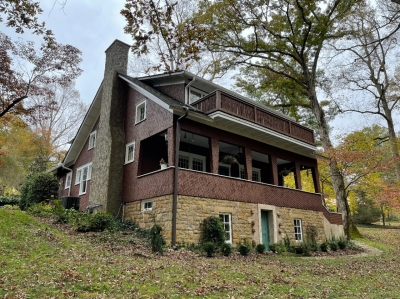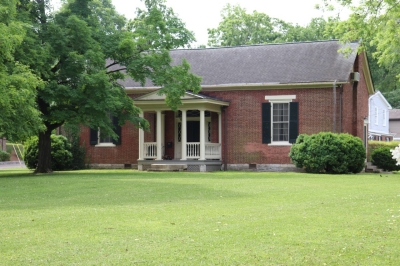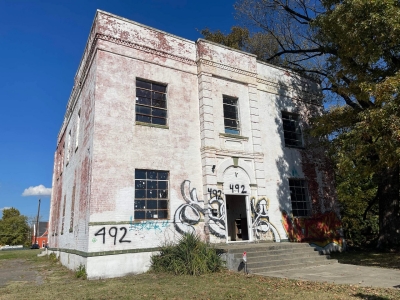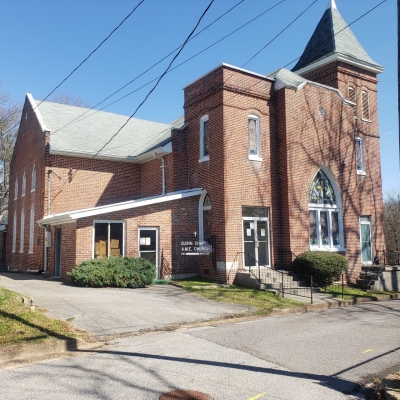Recent National Register Listings
Every year, Tennessee National Register staff assist and provide guidance to property owners across the state as they navigate the National Register of Historic Places listing process. The culmination of this process and the many hours of research, writing, and revision, is the successful listing of a property in the National Register. Listing in the National Register is a testament to the significance of the property , and the hard work and dedication of those involved in the nomination process.
This page celebrates and recognizes our recent National Register-listed properties. To view a property, simply click on the property's name. A brief explanation of the property's significance, a photograph, and the approved National Register nomination accompany each tab. For more information on how to list a property in the National Register, please see our listing process webpage. To learn more about what the National Register does and does not do, visit our National Register FAQ webpage.
2025
The Old Stone Creamery is located in Spring Hill, Maury County. Listed in the National Register on August 1, 2025, the Old Stone Creamery is a locally significant example of a nineteenth century dairy building. The building was constructed in 1870 by Campbell Brown and his cousin McCoy “Mark” Campbell, the latter of whom was the founder of the National Register-listed Cleburne Jersey Farm. Campbell and his descendants transformed their small operation into a dairy farm recognized across the state for its dairy production. The Old Stone Creamery possesses the character defining features of a nineteenth century dairy building. This includes its stone construction, below grade rooms, “wet room” and “dry room” arrangement, plaster interior, and floor-level trough. Additionally, the clipped gable slate roof and wood gingerbread detailing demonstrate subtle applications of architectural detail to an otherwise utilitarian building. The Old Stone Creamery is now the namesake and logo of the Cleburne Jersey Farm, which is operated by descendants of the Campbell family. Milk produced onsite comes from the same bloodline of Jersey cattle bought by Mack Campbell more than one hundred years ago. The family is committed to the preservation of the building for future generations.
Download and view the National Register nomination here.
Located on Cedar Avenue near Cookeville’s town square, Ralph’s Donut Shop was listed in the National Register on August 1, 2025, for its local significance as a donut shop. The building was constructed in 1950 and originally housed Grogan’s Grocery Store. Ralph and Evelyn Smith purchased the building and established Ralph’s Donuts in September of 1962. Both were natives of the Upper Cumberland region and learned about the donut business from Evelyn’s brother, who owned a shop in Dayton, Ohio. Ralph’s Donuts was originally open twenty-four hours a day, seven days a week. This schedule, combined with excellent donuts and baked goods, transformed the business from local shop to community staple. College students from nearby Tennessee Tech University thronged the store in the evening and at night, while working and professional class locals packed the shop in the morning and at lunch. The success of the store is apparent in the accolades and network of fans it accumulated over the years. Ralph’s Donut hats can be found as far afield as Portland, Oregon, and in 2015, Ralph’s donuts was voted the Best Donut Shop in Tennessee. In 2020, the current owners, John and Sandy MacDonald, purchased the shop. They pursued National Register listing to honor the history of Ralph’s Donuts and are dedicated to continuing its legacy.
Download and view the National Register nomination here.
Earles Drug Store was listed in the National Register on August 1, 2025, for its local significance as an important business in Kingsport, Sullivan County. Dr. George W. Earles and Dr. J.A. Flora opened Earles Drug Store in 1941 at 120 East Center Street. The original store offered soda and luncheonette services on the first floor and medical offices on the second floor. As the population of Kingsport increased and Earles Drug Store grew in popularity, the need for a larger building became apparent. Janie Earles, who took over the business after her husband died in 1953, realized that a large, modern building with leasable offices would provide enough space for her business while also combining other healthcare services under one roof. Local architectural Allen N. Dryden, Sr., designed the new modern building that now sits on West Center Street. A large cafeteria and luncheonette that could seat 103 people occupied the first floor. Meanwhile, the second and third floors housed medical offices. People could now visit one place and buy lunch and other supplies, receive medical care, and have their prescription filled. Even more importantly, the new building featured the first drive through window in Kingsport. This combination of modern conveniences and state-of-the-art facilities ensured the new Earles Drug Store became a staple in the Kingsport community. In 1976, the store moved to a smaller location on Center Street, and the building was purchased by the law firm Todd and Dossett in 1977. The current owner is participating in the Federal Historic Tax Credit program and the Tennessee Historic Development Grant program to rehabilitate the building for a new life of service to the community.
Download and view the National Register nomination here.
The Haywood County Farm and Cemetery was listed in the National Register on May 28, 2025, for its social significance. In 1868, Haywood County purchased a farm of 150 acres four miles east of Brownsville for the express purpose of constructing a county “Poorhouse.” An asylum was later added in 1884. In 1915, the county constructed additional buildings to house prisoners. The property became known as the Haywood County Work Farm after this change. From 1915 to 1957, the elderly, mentally ill, and prisoners alike lived and worked on the farm. Their stories convey early concepts of caring for the rural indignant and southern prison reform in Haywood County. In 1957, the property transitioned to a convict only farm. Prisoners were housed there until 2011, when they and prison staff were transferred to the Haywood County Justice Center. Today, the property is owned by the county and cared for by the Haywood Heritage Foundation and the Haywood County Farm Committee. The 1990 jail annex is currently used as archival space, and in 2023, both organizations spearheaded the installation of the Haywood County Farm Memorial Marker in the cemetery to honor those who died on the farm.
Download and view the National Register nomination here.
Sited on the eastern side of Chattanooga near Missionary Ridge, Pleasant Garden Cemetery was listed in the National Register on April 7, 2025, in recognition of its local importance as an African American cemetery. The cemetery was founded in 1890 during the time of Jim Crow, a period of racial segregation, discrimination, and violence against African Americans. Prior to the founding of Pleasant Garden, local African Americans faced limited burial options. However, by the late 1960s, Pleasant Garden had grown into Chattanooga’s largest African American cemetery. Those interred there were associated with major trends in African American history, including enslavement, community building, Jim Crow violence, and the Civil Rights Movement. Working class and prominent leaders alike rest in Pleasant Garden Cemetery. The cemetery is also significant for possessing a physical design characteristic of an African American cemetery. This includes its hilly terrain, nonlinear burial pattern, and vernacular handmade tombstones. Indeed, many of the tombstones present in the cemetery provide windows into the lives of the people it honors and the family that commissioned the tombstone, such as Otis “Hot Sauce” Washington and Bessie Smith’s markers. The cemetery is currently under the stewardship of the African American Cemetery Preservation Fund (AACPF). This organization works tirelessly to maintain and preserve the Pleasant Garden Cemetery and other Chattanooga African American cemeteries for future generations.
Download and view the National Register nomination here.
The Barber Cottage is located in Knoxville, Knox County and was listed in the National Register on April 2, 2025, for its architectural significance as the work of a master architect. The cottage was constructed in 1912 and designed by the well-known and celebrated architect, George F. Barber. Barber mastered the “mail order” method of architectural practice. His most popular plans featured sprawling Queen Anne suburban homes, many of which still stand and are National Register-listed individually or in a historic district. In contrast, the Barber Cottage was designed to be a retirement home for George and his wife Laura. A restrained Craftsman-inspired Dutch Colonial Revival, the Greek front porch, wide Dolly Varden profile cladding, wide overhanging eaves, and simple dormer are a major departure from his elaborate Queen Anne homes. As such, the nominated house provides a unique glimpse into the mind of a master architect designing a house meant to suit his own family’s needs and aesthetic sensibilities, rather than a product for mass consumption. The current owner has worked tirelessly to restore and preserve this important part of Barber’s architectural legacy.
Download and view the National Register nomination here.
Central High School in Alamo, Crockett County, was listed in the National Register on April 2, 2025, for its educational and social significance. From 1950 to 1970, Central School served as the only public high school for African American children in Crockett County. The first two high schools in Alamo burned in the 1930s and 1950. The current red brick building was constructed later that same year on Conley Road about a mile from the school’s original location. Central High School was known for its academic excellence. In addition to core courses like English, Math, Social Studies, and Science, the school offered classes in French, cosmetology, home economics, and Building and Trade. Central High School also offered extracurricular activities and was well-known for their basketball program. After hours it became a center for community life, hosting fundraisers, community meetings, and field days for the surrounding elementary schools. The school building served brief tenures as an elementary school and junior high school after Crockett County desegregated in 1970. Today the building is owned by the Central High School Alumni & Associates and is known locally as the Crockett County Community and Family Resource Center. The alumni group and school continue to serve the community through programs such as YMCA, Save the Children Head Start, and summer camps.
Download and view the National Register nomination here.
Located in Sweetwater in Monroe County, the James M. Pardue House was listed in the National Register on March 21, 2025, for its local architectural significance. The house was constructed in 1896 to serve as the home for James McClellan and Rebecca Pardue. James was an important member of the Sweetwater community, having first served stints in the Tennessee House and Senate in Nashville before returning to serve as the town Postmaster and director of Sweetwater city schools. The Pardue House is a great local example of the Folk Victorian style with prominent Queen Anne influences. The spread and popularity of the style was made possible by the expansion of the railroad system and rapid industrialization. This made acquiring construction materials and intricate wood detailing easier and cheaper for homeowners like James and Rebecca. Many of the style’s hallmarks are visible on the Pardue House. This includes the porch detailing, complex asymmetrical façade, wrap around porch, projecting bay windows, decorative gable field shingle pattern, and steeply pitched cross gable roof. Important interior features include an elaborate wood staircase and multiple original fireplaces. The current owner acquired the house in 2012. Since then, he has maintained the house and conducted historically-accurate repairs to honor its history and significance.
Download and view the National Register nomination here.
The Emory Place Historic District Boundary Increase was approved by the National Park Service on March 20, 2025. The expansion captured a single building, the Boiler House for the Sanitary Laundry Building. Emory Place Historic District began developing into a social, commercial, and transportation center for North Knoxville residents around 1890. The arrival of Knoxville’s first streetcar line fueled commercial and residential development in the district. One of the new businesses was the Sanitary Laundry, sited on North Broadway adjacent to the streetcar line. Constructed in 1926, the laundry building was considered innovative for its machinery and overall design. The boiler house was an important part of the business’s operation. Connected to the main building through a series of pipes, the boiler house provided the heat and steam used in the laundry process. Plans are in place to take advantage of the Federal Historic Tax Credit program to breathe new life into the complex.
Download and view the National Register nomination here.
The Southern Bell Telephone and Telegraph Building is located in Morristown, Hamblen County and was listed in the National Register on March 10, 2025. From 1929 to 1958, the Southern Bell building provided essential communication services to both Morristown and the broader county. Morristown was served by a variety of smaller, independent telecommunications entities in the area before Southern Bell acquired the People’s Telephone Company of Knoxville in 1928. This acquisition made Southern Bell the sole provider of communication services in the area. Construction on the nominated building began a year later, and the inaugural call was placed on February 22, 1930. Local demand soon outpaced capacity, requiring the construction of an addition on the back of the building in the mid-1940s and 1950s. In addition to offering telephone services, Southern Bell was also an important part of the city and county’s economy. The company created some of the largest tax revenues in Hamblen County in 1953. It also offered employment opportunities for locals, including the famous “Hello Girls” who served as switchboard operators. In 1958, Southern Bell constructed a new building to house the dial telephone system, thus ending the nominated building’s tenure as the communication hub for Morristown and Hamblen County. The current owner plans on taking advantage of the Federal Historic Tax Credit program to transform the building into multi-family housing.
Download and view the National Register nomination here.
The Hurdlow School was listed in the National Register on March 20, 2025, in recognition of its local educational and social significance. The school is located on Wet Prong Road in the small community of Hurdlow near Lynchburg in Moore County. Like other rural areas across the state, students who lived in Hurdlow did not have access to facilities like their counterparts in cities and urban areas. Many of the early schools in the area were small, wood frame, single-room schools. The construction of the nominated building in 1949 represented a substantial investment in the educational life of students in the area. Hurdlow School offered modern conveniences like a fully operation and stocked kitchen, indoor plumbing, and electricity. Outside, students could play on a baseball field and basketball court. Grades 1-8 were offered at the school and students learned reading, writing, mathematics, and science. After school clubs, including 4-H and choir, offered enrichment activities for students after hours. Hurdlow School was also the center of the community’s social and cultural life. Pageants, fundraisers, visiting dignitaries, adult school, and fish fries were just a few of the events hosted in the building. The school closed in 1962 as part of Moore County’s continuing school consolidation efforts. Hurdlow School is now owned by a member of the community who plans on ensuring the story and significance of the school is not forgotten.
Download and view the National Register nomination here.
2024
The "See Rock City" Signs in Tennessee Multiple Property Documentation Form (MPDF) was approved by the National Park Service on December 23, 2024. The MPDF documents the history of the advertising campaign for Rock City Gardens, a tourist attraction atop Lookout Mountain near Chattanooga. Frieda Utermoehlen Carter and her husband, Garnet Carter, opened the Gardens in 1932. In 1935, the Caters began a roadside advertising campaign that brought the phrase "See Rock City" to American highways as far north as Lansing, Michigan and throughout the southeast and midwestern United States. They hired Clark Byers to paint signs on barns alongside roads which were leased for a small fee. By 1956, Byers had painted more than 800 signs throughout the country. However, a combination of several factors lead to the destruction of the majority of the signs, leaving around 40 extant today. The MPDF establishes the requirements for barns in Tennessee to be efficiently listed in the National Register of Historic Places.
Download and view the National Register nomination here.
Listed in the National Register of Historic Places on December 23, 2024, the "See Rock City" Barn near Crossville, Tennessee, has been part of Rock City Gardens' advertising campaign since 1953. Then owned by the Ford Family and later the Buhaly Family, the barn exemplifies the design of "See Rock City" signs. The barn's placement at the bottom of a hill where Tennessee State Route 68 curves ensured that it was eye-catching and therefore effective for marketing Rock City Gardens where visitors could "See 7 States." This 'See Rock City" barn was featured in an exhibit at the 1982 World's Fair in Knoxville and is also on the cover of David B. Jenkins' book Rock City Barns: A Passing Era.
Download and view the National Register nomination here.
The First National Bank Operations Center was listed in the National Register of Historic Places on December 18, 2024. Constructed in 1971 in the Court Avenue 1 urban renewal area in Memphis, the Operations Center is significant as an important example of the Brutalist style in Memphis, Shelby County. The style's name is derived from the French phrase "beton brut," which means raw concrete. Brutalism is known for its massive compositions and honest expression of materials, particularly concrete. The Operation Center's modular design was intended to express strength and modernity while also providing flexible office space for bank staff and the company's state-of-the-art computer system, which could read 41,600 characters per minute. The computers could also store the bank's entire record system, a major technological advancement at the time. This allowed the bank to more securely and quickly serve its customers while also expanding its services.
Download and view the National Register nomination here.
Nestled along Anderson Pike near the historic W Road in the Town of Walden on Signal Mountain, the Bachman-McCoy farm was listed in the National Register of Historic Places on December 2, 2024, for its historical significance. Bachman family members played significant roles in local politics, social reform causes, and environmental preservation. In 1911 Nathan L. Bachman purchased the property as a summer home for his family. By 1918, the Bachmans had transformed the property into a full-time residence and gentleman’s farm. With the farm as his home base, Nathan L. Bachman rose in Tennessee’s political world, serving in the Tennessee Supreme Court and as an important southern Senator in the U.S. Congress during the first phase of the New Deal from 1933 to 1936. He played roles in the creation of the Tennessee Valley Authority and the passage of the Social Security Act. His wife, Pearl Duke Bachman, had significant involvement in the local Garden Club movement. She was an early advocate for land conservation and other social causes. Their daughter, Martha Bachman McCoy, became a powerful voice for highway beautification. Martha and her family became the farm’s primary residents ca.1940. Her will transferred the farm to the Town of Walden for use as a public park. The property’s 38 acres are now open daily for outdoor recreation and events.
Download and view the National Register nomination here.
The Rosenwald Recreation and Community Center in Shelbyville was listed in the National Register on November 21, 2024, under Criterion A for its local significance in the educational and social life of the surrounding African American community. In 1929, local African American citizens formed clubs to fundraise for the establishment of a larger school for their children. Known as the Rosenwald Clubs, the organizations met monthly with a Rosenwald Building Agent named Professor Robert E. Clay. The clubs raised approximately $1700 and purchased two lots of land for a school. However, Shelbyville and Bedford County opened the Bedford County Training in School in 1939. In response, community members used the funds and land to build the Rosenwald Recreation and Community Building for the use and benefit of the local African American community. The building hosted vital community activities, including tutoring, art classes, and family festivals. Outdoors sports like baseball and basketball were held on the grounds, and the large backyard was used for band practice. The center continued to be an important asset into the 1980s and 1990s and served as the location for the South Central Human Resource Agency’s Early HeadStart Program for twenty-years until 2020. The Rosenwald organization continues to maintain the building and serve the local community.
Download and view the National Register nomination here.
Located in Jefferson City, the Mossy Creek Presbyterian Church was listed in the National Register on November 6, 2024, for local architectural significance under Criterion C as an excellent example of its style. The original portion of the church was constructed in 1871 and featured a two-story bell tower on the façade, imposing brick pilasters, decorative brick turrets, and tall-arched windows. An addition was constructed on the rear of the church in 1949 to accommodate the church’s growing needs. The rear addition is characterized by its modest Colonial Revival influences. Nomination research concluded that Mossy Creek Presbyterian Church may be one of the earliest surviving examples of its style as it pertains to religious architecture in East Tennessee. The church currently houses the First Presbyterian Church of Jefferson County. The congregation continues to preserve the church building and serves the local community through various outreach programs.
Download and view the National Register nomination here.
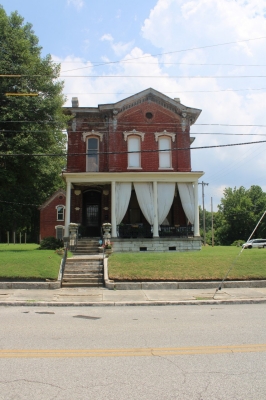
The West J. Crawford House was listed in the National Register on November 4, 2024, under Criterion C for its local architectural significance. The handsome Italianate residence was constructed in 1877 to serve as the home of West J. Crawford and Annie Louise Thompson. It was once part of the formerly-listed Vance-Pontotoc Historic District, a neighborhood locally known as “Millionaire’s Row.” Wealthy Memphians like Crawford constructed lavish houses in the Italianate, Queen Anne, and other Victorian-era styles in the area. Now, the West J. Crawford is the only remaining Italianate House on Lauderdale Street, and one of the last three houses that comprised the original neighborhood. Important features of the Crawford House including its side-passage plan, brick construction, arched hooded windows, overhanging eaves, decorative brackets, and classically-influenced porch.
Download and view the National Register nomination here.
Located on the outskirts of Memphis, the Ell Persons Lynching Site was listed under Criterion A at the state and local levels of significance on August 7, 2024, for its association with the lynching of Ell Persons on May 22, 1917. Ell Persons was a local African American man and woodcutter accused of murdering a sixteen-year-old white girl, Antoinette Rappel. Police began their investigation into Rappel’s murder after her body was found on May 2, 1917. Though all the evidence suggested a white assailant, the Memphis sheriff insisted that she was murdered by an African American worker. Ell Persons was taken into police custody as a suspect when his employer E.J. Brooks reported that Persons acted suspiciously. Persons was interrogated for hours, during which time he was beaten by officers until they reportedly obtained a forced confession. A white mob removed Persons from prison and, in front of approximately 5,000 men, women, and children, burned Persons alive before decapitating his body. His head and foot were later tossed into a group of African American men on Beale Street as a warning. Person’s lynching sparked national outrage. The Boston branch of the Equal Rights League sent a telegram to President Woodrow Wilson about the lynching, urging him to prevent further instances from happening. In July 1917, approximately 10,000 African Americans marched in New York City to protest the lynching, and several others, in what became known as The Silent Protest Parade. Back in Memphis, African Americans organized to form the Memphis branch of the National Association for the Advancement of Colored People (NAACP), which played a key role in the Civil Rights movement. The Ell Persons Lynching Site today remains undeveloped and is a potent reminder of the racial terror inflicted on African Americans and the movement for change it sparked.
Download and view the National Register nomination here.
The Clark Memorial Methodist Complex in Nashville, Davidson County was listed in the National Register on August 2, 2024, under “The Civil Rights Movement in Nashville, Tennessee, 1942-1969” National Register Multiple Property Documentation Form for its important role in the Civil Rights Movement. The complex consists of the 1945 sanctuary, 1956 parsonage, 1941 Walker House, and several outbuildings. From 1945-1964, the Clark complex hosted training workshops, community meetings, conferences, fundraisers, and other important events that fueled the Nashville Civil Rights Movement. The complex is also associated with legendary Civil Rights leader James M. Lawson, Jr. and physician Dr. Charles J. Walker. Lawson led nonviolent, direct-action training workshops at the Clark complex from 1958 to 1959. Considered to be one of the most important contributing factors to the Nashville Civil Rights Movement’s success, Lawson’s workshops prepared both students and young people for the protests and demonstrations that made 1960 the most active protest year in the history of the Nashville movement. Dr. Walker, a minister and local leader within the Nashville movement, also lived on the Clark Campus. It is this confluence of activism, leadership, and training that made the Clark complex the “cradle” of the Nashville Civil Rights Movement. The nomination was partially funded by the National Park Service's African American Civil Rights grant.
Download and view the National Register nomination here.
First Community Church in Nashville, Davidson County was listed in the National Register under “The Civil Rights Movement in Nashville, Tennessee, 1942-1969” National Register Multiple Property Documentation Form for its role in the Civil Rights Movement on August 2, 2024. The First Community Church building was constructed in 1960 around an earlier building on the same property. From 1957-1969, First Community Church served as a strategy center for the Nashville Civil Rights movement and sponsored other important community events, such as voter registration drives and seminars on race relations. The church is also significant for its association with Reverend Cordy Tindell (C.T.) Vivian, who pastored the church from 1957-1961. Rev. Vivian is recognized as one of the three major pastors who was responsible for the success of the Nashville Civil Rights Movement. The Reverend organized and participated in the many workshops and trainings that prepared activists for the rigors and challenges the Civil Rights Movement faced in Nashville. He also oversaw the construction of a modern church building that reflected the property’s important role as both a house of worship and instrument of social justice. The church and congregation continued to be heavily involved with the Civil Rights Movement following Rev. Vivian’s departure, with one member, Johnetta Hayes, serving as the first female president of the Nashville branch of the NAACP from 1959-1962. Strategy centers like the First Community Church were critical components of the Nashville Civil Rights movement.
Download and view the National Register nomination here.
The Civil Rights Movement in Nashville, Tennessee, 1942-1969 Multiple Property Documentation Form was approved by the National Park Service on August 2, 2024. The MPDF documents the important history of the Civil Rights Movement in Nashville between 1942-1969 and identifies the many different types of cultural resources that are associated with this important movement. The push for Civil Rights in Nashville began following the conclusion of the Civil War and gained momentum during the World War II era. The Southern Conference for Human Welfare established their headquarters in Nashville in the 1940s. Around the same time, Fisk University also launched the Race Relations Institute, an innovative program that sponsored race relations workshops. These early events set the stage for the nonviolent, direct action training workshops in the 1950s, which in turn transformed Nashville into the center for young civil rights activists in the State. The successful desegregation of Nashville’s public accommodations between 1958 and 1964 are testament to the dedication and planning of the movement members. The MPDF identifies three property types associated with the movement, including strategy centers, conflict centers, and properties associated with prominent persons. Thanks to the thorough research and survey present in the MPDF, Civil Rights-related resources in Nashville can be more easily listed in the National Register in the future. The multiple was partially funded by the National Park Service's African American Civil Rights grant.
Download and view the National Register nomination here.
Located in the city of McKenzie in Carroll and Weakley Counties, the Webb Public School was listed in the National Register under Criterion A on May 10, 2024, for its educational significance. The first school for African American children in McKenzie was organized in a local church building in 1898. The introduction of the public school system soon after led to the establishment of the first official school for African American students, the Booker T. Washington School. Attendance rapidly outgrew the Washington School’s capacity, which led to the construction of multiple schools during the early-twentieth century, including a four-room Rosenwald School and an expansion of the McTyeire College campus in McKenzie. The nominated Webb Public School was built in 1958. Named after John L. Webb for his generous financial contributions and support of expansion drives, the Webb Public School was the only public high school available to African American children in both counties. The school offered courses in Social Studies, Math, Agriculture, and Language. Extracurricular activities like football, basketball, band, and glee clubs offered students enrichment opportunities beyond academics. Webb Public School closed in 1966 following desegregation. In 1969, alumni of the school joined together to form the Webb Alumni Association. The Association now owns the building and continues to use the property as a center for education and community service in McKenzie.
Download and view the National Register nomination here.
The Cedar Heights Farmhouse was listed under Criterion C on May 10, 2024, for its local architectural significance as a good example of the Folk Victorian style. The Farmhouse was constructed in 1891 on land that belonged to the Williamson family, one of the wealthiest and most influential families in the then small town of Mt. Juliet. The Folk Victorian style was popular across the nation from roughly 1870-1910. The rise of the railroad system, pre-milled lumber, and affordable wood decorative elements contributed to its popularity. Important characteristics of the Folk Victorian style include spindle-work detailing, flat jigsaw cut trim, cornice line brackets, asymmetrical floor plans, and frequent ell-shaped additions. The Cedar Heights Farmhouse exemplifies many of these details, while also boasting unique architectural features more common to the Queen Anne style. This includes its wraparound porch, two story height, oculus window, pediments with rosette design, and intricate porch details. The interior also boasts the original staircase, decorative fireplace mantels, and wood door and window surrounds. The house was passed down through the family until the current owner was deeded the property in 2017. Since then, he has worked to restore, protect, and preserve the house, ensuring that it remains a prominent landmark in the city.
Download and view the National Register nomination here.
The Cross—Boggs Place was listed in the National Register on May 6, 2024, under Criterion C for its local architectural significance. Joseph Black Cross built the house circa 1860 in the small community of Dorsett in East Tennessee. The Cross—Boggs Place was initially constructed as an I-House, a well-known vernacular style characterized by its two-story height, one-room depth, three-to-five symmetrical façade openings, central hall plan, and optional front porch. It was later renovated in the Folk Victorian style in 1900 before it gained its current Classical Revival appearance in 1930. The two-story flat roof porch with columns, exterior end chimneys, and ornate door and window surrounds mark the house as a locally important example of the Classical Revival type. Joseph’s daughter, Hanna Mae Cross, and her husband, M.E. “Ted” Boggs, bought out the remainder of the Cross siblings in the early twentieth century to become the sole owners of the property. The house remained in the Boggs family until 1945, after which it changed hands until the current owner, Bonnie Shoemaker, purchased the home in 1993. The East Tennessee Development District recognized her preservation efforts and successful National Register listing with an award presented at the September 2024 District Celebration ceremony.
Download and view the National Register nomination here.
Townsend School is located on South Shepard Street in Winchester, Franklin County. The school was listed in the National Register under Criterion A on April 23, 2024, for its role in the educational, social, and cultural history of the surrounding community. In May of 1933, the Franklin County board of education appointed a committee to build a school for local African American students after the previous school burned down. The Townsend School was finished later that year. Despite being completed after the Rosenwald building program ended, the Townsend School shares many design similarities with Rosenwald Fund school plans. The school building was improved in 1949, 1954, and 1962 by the county in an attempt to “equalize” schools and avoid integration. Throughout its history, the Townsend School served as the center of a vibrant and close knit African American community. In addition to offering a quality education, the school also hosted community events such as fish fries, plays, musicals, and patriotic events during World War II. Franklin County desegregated in 1964, and Townsend closed two years after. Today the school is known as the Townsend Center. It houses the Townsend Cultural Center and a museum with interpretive panels and artifacts. The community continues to use the building as a vehicle for positive community outreach and change.
Download and view the National Register nomination here.
Woodlawn Baptist Church, located in Nutbush, Haywood County, was listed in the National Register under Criterion C on March 15, 2024, for its local architectural significance. Nutbush is one of the oldest communities in Haywood County, and the Woodlawn Baptist Church congregation has played a vital role in the community since it was founded in 1846. The nominated church was built in 1916 on land donated by the Solomon family after the previous church building burned in 1915. It was constructed in the Gothic Revival style, as demonstrated by its pointed arch windows. However, what separates the church from other local examples is its unique Akron Plan arrangement. This plan featured rooms along the sanctuary equipped with moveable doors and walls to create smaller spaces for religious or educational meetings. Woodlawn uses tri-fold doors on the interior to accomplish the Akron Plan. Other important features of the church include wood ceilings, wainscoting, and wood floors. The congregation continues to use the church and maintain it much as their forebears did in years past.
Download and view the National Register nomination here.
The Esso Filling Station was listed in the National Register under Criterion A and Criterion C on March 14, 2024, for its commercial and architectural significance. C.T. Hooper, Jr. built the Filling Station in 1937 at the corner of Franklin Street and North Washington Avenue in Brownsville, Haywood County. The station was a popular stop along the Memphis-Bristol Highway. Under the Hooper family, the station became known for its full-service approach to automotive care, providing such products as gasoline, tires, batteries, lubrication services, and oil additives. The Esso Filling Station is also an important local example of the Art Deco and Streamline Moderne architectural styles. Important features include its stepped parapet, smooth wall surfaces, belt courses, and curved canopy. The family sold the building in 1996 to Lawrence Baxter. Baxter Graphics now calls the Esso Filling Station home, and the current owners continue to preserve and respect the property’s long history.
Download and view the National Register nomination here.
The Cherokee Arms is located in Memphis, Shelby County and was listed in the National Register under Criterion A and C on March 6, 2024, for local significance in architecture and community planning. William E. Barnes, a local real estate speculator, acquired land from Mary T. Sullivan in April of 1921. Barnes hired G. Lloyd Preacher, a prestigious architect from Atlanta, Georgia, and local architect Charles Deas to design an apartment building for the newly acquired lot. Gude and Company, also of Atlanta, were hired to build the apartments, which were finished in 1923. Upon its completion, the Cherokee Arms became a locally important example of the Italian Renaissance style as expressed in a Block Type apartment building. Important characteristics of the style include its terra cotta inlays and coping, brickwork, fenestration patterns, compact massing, and central interior hallway. The Cherokee Arms was also significant as one several apartment complexes built to house the burgeoning middle-class arriving in the city during the early twentieth century. The current owners pursued National Register listing to assist with preserving the building and to recognize its beauty.
Download and view the National Register nomination here.
Located in the community of Scattersville in Sumner County, the Scattersville Public School was listed in the National Register on February 7, 2024, for its educational significance. The school was constructed in 1928 on land donated by Henry Seten Bell and his wife Sarah Bell. It was a one room schoolhouse and housed grades one through twelve. At the time of its construction, it was the only school available for African American children in the Scattersville, Mitchelville, and Corntown communities. Students were offered courses in reading, writing, mathematics, industrial training, home economics, and physical education. Students also had access to a well-maintained library of over 225 books. The school closed in 1962, at which point students were bused to Union High School, an African American school in Gallatin. Sumner County fully desegregated eight years later. Since then, the Scattersville Public School has served as a community center. Softball games, fish fries, and even funerals were held on the property. Community members continue to preserve and maintain the property for future generations to enjoy.
Download and view the National Register nomination here.
2023
Located in Monroe County, Fort Armistead was listed as a National Historic Landmark on December 11, 2023, for its association with events that have made a significant impact on United States history. In 1830, President Andrew Jackson introduced the Indian Removal Act. This act resulted in the forcible removal of the southeastern Indigenous people from their ancestral homes to lands out west. The Cherokee nation was one of the groups affected by the passage of the Act. When the elected leaders of the Cherokee refused to negotiate a removal treaty and comply with the act, the United States government opened negotiations with the minority of Cherokee in favor of removal. Major Ridge and his son John Ridge, the leaders of this faction, signed the Treaty of New Echota in December of 1835. This treaty ceded all Cherokee lands east of the Mississippi and consigned the Cherokee peoples to be relocated to “Arkansas County,” thus beginning the Trail of Tears. Fort Armistead was one of the federal military installations that facilitated Cherokee removal out west. Today, Fort Armistead is the only military post associated with the Trail of Tears that contains substantial archaeological integrity, including subsurface elements of buildings present during removal and artifact deposits. It is because of this potential to recover the stories and experiences of those during the Trail of Tears that Fort Armistead was declared a National Historic Landmark.
Because the property contains sensitive archeological resources, a redacted copy of the final form will be provided for public viewing at a later time.
Located in Memphis, Shelby County, the nominated property was listed on December 4, 2023, under Criterion A for its local significance as the headquarters of the Omicron Sigma Chapter of Sigma Gamma Rho Sorority and for its architecture. The house was originally constructed circa 1913 by John H. Fisher and is an important local example of the Folk Victorian style. Many of its original architectural characteristics remain, including its decorative brackets and elaborate porch. The Omicron Sigma Chapter acquired the house in August of 1957 from the Top Hat & Tails Club. Founded in May of 1937, the Omicron Sigma Chapter is part of Sigma Gamma Rho, an international African American sorority dedicated to the advancement of their members’ personal and professional lives and one of the “Divine Nine”. The chapter hosted many of their most important community service events at the house, including the Teen-Town program and “Rhomania”. The Sorors of Omicron Sigma continue to maintain the property and serve the community through various programming, including Operation BigBookBag, Project Cradle Care, and RHOck the Vote!.
Download and view the National Register nomination here.
The Central Gardens Historic District in Memphis was originally listed in the National Register of Historic Places in 1982. Central Gardens was one of the most prestigious communities in Memphis during the early twentieth century, and many of the city’s most prominent citizens called the neighborhood home. The earliest building in the neighborhood was constructed in 1852, though the most intensive development in the neighborhood occurred between 1905 and 1925. The updated nomination explores this evolution and the impact that the neighborhood had on Memphis’ broader community planning initiatives, in addition to reiterating the architectural significance of the district. Central Gardens was recognized as a Historic Conservation District by the Memphis Landmarks Commission in 1993. This recognition and the efforts of the Central Gardens Association ensures the district continues to be preserved and protected. The updated nomination was partially funded by the Tennessee Historical Commission's Historic Preservation Fund grant.
Download and view the National Register nomination here.
The Harlin House is located near the Harlinsdale Farm in Franklin, Williamson County and is locally significant for its history and architecture. The Harlin House was constructed circa 1860 and served as the residence for multiple owners in the area. In 1942, Alex F. Harlin and William Wirt Harlin bought the property when they expanded their horse farm. The house became the home of Wirt’s son and daughter-in-law, Bill Harlin and Barbara Ann Nunnaly. Bill played a major role in Harlinsdale Farm’s operations and served as the President of the Tennessee Walking Horse Breeders’ and Exhibitors’ Association. The Harlin family lived in the house until 1974. Because the Harlin House was associated with the Harlinsdale Farm during the Harlin’s tenure, the boundaries for the original Harlinsdale Farm nomination were expanded to include the Harlin House. The current owner continues to preserve and maintain stewardship of the house.
Download and view the National Register nomination here.
The Martin Downtown Commercial Historic District is a collection of commercial buildings located within the city of Martin in Weakley County. It was listed in the National Register on July 10, 2023, for its local historical significance. The district collectively tells the story of Martin’s growth from its origin as a railroad town in 1873, to the district’s modernization in the 1970s and 1980s. William Martin originally owned the land that the district was built on, though he died before the city was founded. His sons made a deal with the Mississippi Central Railroad, which resulted in the intersection of the Mississippi Central Railroad and the existing Nashville and Northwestern line on their family’s land. Surveyor H.C. Draughn laid out the town of Martin in September of 1874 around the railroad intersection, and the town was incorporated that same year. Martin grew rapidly throughout the nineteenth and early-twentieth centuries. The Great Depression resulted in hard times for the businesses within the district’s boundaries, but by the end of World War II, the district had recovered. The arrival of a new shopping center strip and Walmart caused the district to decline in the 1970s and 1980s. However, recent efforts by local preservation groups and concerned citizens have seen new life breathed into the commercial district.
Download and view the National Register nomination here.
Bruce High School, located on Vernon Street in Dyersburg, Dyer County, was listed under Criterion A on July 6, 2023, for the crucial role it played in the education and daily life of the historically African American Bruce neighborhood. The current building was constructed in 1951, making it the third building to house Bruce High School. It was the only place Black Dyer Countians could obtain a secondary education during the period of Jim Crow segregation. The school served the educational and social needs of the surrounding community from its construction in 1951 until its closure in 1972. Reading, arithmetic, science, geography, civic classes, French, and building and trade classes were offered at the school. Students were also able to participate in many extracurricular activities, including the New Farmers of America and New Homemakers of America clubs, marching band, football, and choir. After the school closed, city officials demolished the high school wing and library, and the building reopened as the Bruce Community Center. In 1983, several female alumni began holding a biennial Bruce alumni reunion at the community center and were instrumental in starting the nomination process.
Download and view the National Register nomination here.
The Haynes Haven Stock Farm in Spring Hill was listed in the National Register of Historic Places on July 6, 2023, for both its architecture and statewide significance for its association with the breeding, training, and showing of Tennessee Walking Horses. Dr. Spivey McKissack founded Woodlawn in 1824. The farm rapidly gained a name for its pacing and show horses, a reputation it maintained throughout the nineteenth and early twentieth century. Colonel John L. Haynes purchased Woodlawn in 1936 and renamed it Haynes Haven. Under Haynes’s ownership, the farm won national acclaim as the home of World Grand Champion, Haynes Peacock. The farm is also home to several important architectural buildings and outbuildings. The Haynes House is a Late Classical Revival home constructed in 1938. A Craftsman stone stable barn and Queen Anne-influenced lattice barn also call the farm home. Haynes Haven remained an important part of the pacing and show horse industry until it was sold by the Haynes family in 1959.
Download and view the National Register nomination here.
Located in the small community of Gassaway near Liberty, The Meltons Bank was listed on July 3, 2023, for the exceptional service the bank and Kidwell family provided to the surrounding community. George G. Melton and his sons chartered and officially opened the first Meltons Bank for business in 1903. They operated the bank out of their mercantile store. After George Melton and his sons passed away, James Kidwell, who worked as assistant and head cashier at the bank, purchased the lot adjacent to the mercantile store in 1925. He constructed the current bank building on the lot that same year, and in 1926, The Meltons Bank moved into the new building. From 1925 to 1986, James Kidwell and his son, Jesse Howard Kidwell, provided the community exceptional service. In addition to offering regular banking services, the Kidwells also served the community as financial advisors, budget directors, and confidants. The First National Bank of Manchester purchased The Meltons Bank in 1987 after Jesse Kidwell passed away in 1986. The bank closed its doors six months after the sale. Gary and Jama Hancock purchased the bank in 2018 and have since transformed The Meltons Bank into the Gassaway Museum, which is open to the public.
Download and view the National Register nomination form here.
The Fox House sits on a ridge above Ovoca Lake along the northern edge of Tullahoma’s city limits in Coffee County. It was listed in the National Register of Historic Places on June 21, 2023, for its local architectural significance. The house was constructed in 1910 for Walter Dennis Fox and his wife Sara Bell Fox. W.D. Fox was a member of the Knights of Pythias fraternal organization and eventually rose to the station of Grand Keeper of the Records and Seal. He played a major role in the establishment of the Knights of Pythias Ovoca Home for Windows and Orphans, which was once located down the ridge from the residence. The Fox House is a locally important example of the Craftsman architectural style. Angled chestnut shingle siding, tapered shingled porch columns, and second-level sleeping porch are all character defining features of the residence. A Craftsman style garage was also constructed on the property in 1933. The Fox House changed ownership several times after the death of W.D. Fox in 1912 until the current owners purchased the property in 1995.
Download and view the National Register nomination here.
The Emory Place Historic District in Knoxville was listed in the National Register on November 10, 1994, for its importance in both architecture and the history of transportation development. This nomination expanded and updated the district to include its significance in the commercial and community planning history in the area. Early growth in North Knoxville gave rise to Central Market, a short, two-block long divided street that was home to a one-story market building constructed in 1890. In April 1905, the City of Knoxville tore down the market building and converted the space the market housed into a public park. It was named Emory Park in honor of Reverend Isaac Emory and was later renamed Emory Place in the mid-1950s. Emory Place quickly became a bustling economic and transportation hub. The first streetcar line established in Knoxville located its southern terminus at North Broadway and Tyson Street, and later several of Knoxville’s first gas stations were located in the district. Buildings in the district housed businesses such as bakeries, grocery stores, furniture store, pharmacies, and dry cleaners. The district declined throughout the second-half of the twentieth-century as businesses relocated to the suburban sprawl of West Knoxville. By the early 1980s, many buildings in the district had deteriorated. However, a combination of federal preservation incentives and community preservation efforts have given the district new life.
Download and view the National Register nomination here.
Lewisburg Avenue Historic District was first nominated on April 13, 1988 for its architectural significance. This update adjusted the boundaries and provided additional architectural information on buildings constructed after World War II. The Lewisburg Avenue Historic District is home to a large collection of residential architecture that reflects evolution in American architecture in the area and the state. Greek Revival, Italianate, Queen Anne, Folk Victorian, Tudor Revival, Colonial Revival, and Craftsman types are all represented. The residential district grew along the former Lewisburg Pike toll road. The Otey-Campbell House was the earliest residence. Development continued southward in the late nineteenth century following the subdivision of land owned by Colonel John B. McEwen. It was the 1920s that brought the most significant building campaign along Lewisburg Avenue. Little has changed in the district since it was listed in 1988, and in 2022 the City of Franklin adopted guidelines for historic districts to assist in their preservation. This update was partially funded by a federal Historic Preservation Fund grant.
Download and view the National Register nomination here.
Located on Elliston Place in Nashville’s “Rock Block,” Exit/In was listed on March 28, 2023, for its exceptional impact on Nashville’s alternative music and entertainment scene. Exit/In opened in 1971, though the building it occupied on Elliston was constructed nearly twenty-years earlier. Owsley Manier and Brugh Reynold were the original owners of the building. Manier and Reynold chose the location because of its proximity to Vanderbilt University and the local neighborhood’s reputation as a “youth-oriented” area. Exit/In quickly established itself as an important alternative music venue in a city known for country music. Since its opening, Exit/In has hosted many important artists, musicians, singers, and songwriters, including Jimmy Buffett, Doc Watson, Joan Baez and Odetta, John Prine, Linda Ronstadt, Billy Joel, and Kris Kristofferson, to name a few. Popular music historians have ranked Exit/In with the Troubadour in Los Angeles and the Bottom Line in New York City as one of the most pivotal popular music clubs in the United States in the 1970s and 1980s.
Download and view the National Register nomination here.
Griggs Business and Practical Arts College was listed in the National Register of Historic Places on March 21, 2023, for local significance under Criterion A. The building occupies a small lot on Vance Avenue in Memphis, Shelby County. The College building was originally constructed in 1858 to serve as the residence for John Minter Gregory and Elizabeth Stovall. The neighborhood surrounding the building at the time of its construction was occupied primarily by affluent, white Memphians. As white Memphians moved eastward in the twentieth century, African-American families moved into the vacancies, bring new life and history to these areas. Reverend S.A. Owens and C.J. Gaston purchased the building on December 15, 1949 to serve as the campus for Griggs Business and Practical Arts College. Founded by educator and civil rights activist Emma Griggs, the college offered practical courses to its students, including shorthand, business English, commercial law, secretarial guidance, and typewriting. More than one-thousand men and women received their education from Griggs, and many alumni went on to hold leadership roles in their communities and professions. The College declined in the 1970s in the face of Urban Renewal and financial problems. It was officially dissolved in 1983. The current owner of the property is committed to preserving the building and transforming it into a vital resource for the surrounding community.
Download and view the National Register nomination form here.
Quinn Chapel A.M.E. Church is located in a historically African American residential neighborhood in Paris, Henry County and was listed in the National Register on January 17, 2023. The church was constructed in 1917 after the previous building burned in 1916. Quinn Chapel and its congregation were an integral part of their surrounding community and the city of Paris. The church sponsored many civic and community outreach programs. The Paris-Henry County Civic League was organized in Quinn Chapel’s basement in 1932, and the Paris-Henry County Branch of the National Association for the Advancement of Colored People (NAACP) hosted events at Quinn Chapel in the 1960s teaching attendees how to apply for jobs or advance their own career. Quinn Chapel was also active within the African Methodist Episcopal (A.M.E.) denomination. The church sponsored other congregations nearby, and their choir was known regionally for their excellence. Current congregation members continue this tradition of community outreach and service.
Download and view the National Register nomination form here.
| Contact | |
|---|---|
| Ethan Holden National.Register@tn.gov (615) 775-0853 |
Rebecca Schmitt National.Register@tn.gov (615) 818-4476 |
